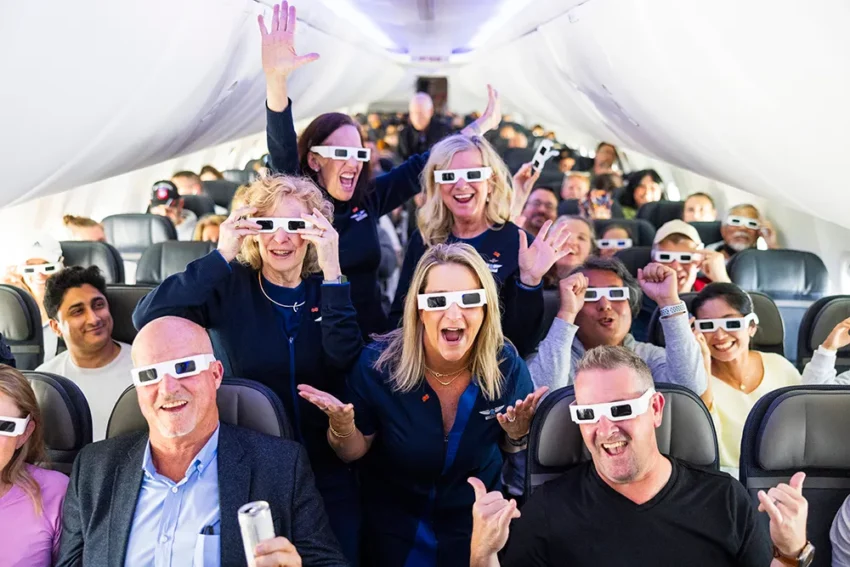Thursday, April 11, 2024

Passengers on Alaska Airlines Flight #322 from San Diego to Dulles were given a unique opportunity to witness Monday’s total eclipse up close. Equipped with eclipse glasses, guests eagerly looked out of their windows to catch a glimpse of this rare celestial spectacle, knowing that such an event won’t be visible in the United States again until 2044.
However, the timing of this experience was not accidental.
“This was the first I had piloted during a solar eclipse, and I actually retire in 2040, so being in the front row was right at the top of the list for some of the best experiences I’ve had in the sky,” said Scott Bunch, Alaska Airlines first officer for Flight #322. “It was great teamwork from everybody involved. We had excellent dispatching that provided a route to keep the aircraft on the path of totality. Not only did we go through the darkness from the moon passing in front of the sun, but we also stayed in it. I was ecstatic.”
Solar eclipse enthusiasts had secured their flights well in advance to witness the full totality from the ground. Flights from Alaska to Austin, Dallas, San Antonio, and Mazatlán, Mexico were fully booked, prompting us to add more flights to these destinations due to the high demand and their projected longer duration of totality.
Here’s how we managed it:
Unlike the 2017 Great American Eclipse, where Alaska Airlines organized a dedicated flight with a team of pilots and an astronomer, this time there was no such elaborate arrangement for a sky view.
As excitement grew leading up to the April 8 event among guests and the media, Joe Demory, Alaska Airlines’ director of dispatch, began examining our existing flight schedules to identify which ones would offer guests the optimal viewing experience.
“We started with basic research by comparing our flight schedule with the eclipse path,” said Demory. “I was able to identify two flights out of San Diego—one to Boston and the other to Dulles—that would give us the best chance of following the eclipse path for the longest period of time.”
However, Demory was aware that factors such as weather, air traffic control (ATC), and other variables beyond our influence could potentially cause flight delays and lead to missing the eclipse entirely.
Recognizing that guests would feel let down if they were unable to witness the moon blocking the sun, Demory enlisted the expertise of veteran Alaska chief dispatchers Ed Fischer and Eric Juchartz to devise the optimal flight route for the pilots on that day.
“We had a small window of time to make this all work, especially for full totality that everyone wanted to see—you want to watch the full eclipse, not the partial,” said Juchartz. “I started with Google Earth, which had an eclipse overlay, so that was kind of cool.”
It took approximately an hour for him to employ various technologies and software in order to chart the optimal route for both flights. This entailed deviating southward from the usual flight paths to Dulles and Boston.
On the day of the eclipse, Fischer, a former aircraft navigator in the U.S. Air Force, examined Juchartz’s flight trajectories and made minor tweaks from the Dispatch center. As a dispatcher, Fischer maintained continuous communication with our pilots throughout the flights to ensure their safe arrival at the destination and to ensure they did not miss witnessing the total solar eclipse.
“We were probably going to intercept it somewhere around Indianapolis is what I guessed, and it was going to be dependent on how strong the winds were and when we actually took off,” said Fischer. “I emailed the crew a list of the eclipse times along their route so they could see about what time they were going to be at different points and then pass it on to our passengers.”
Alaska Airlines dispatchers ensure the success of every flight, including this special one for our guests. They manage all daily flight operations, prioritizing safety, efficiency, and regulatory compliance without fail.
“It was right over Missouri, just shy of the border of Illinois, that we actually got the full eclipse, it was awesome,” said Nick Mentzen, captain at Alaska Airlines, who piloted flight 322. “ATC gave us permission to fly at a lower altitude and do a series of ‘s-turns’ to give our guests on both sides of the plane to get a view, first to the right then followed by a turn to the left and that’s when we actually got the full eclipse.”
“It just goes to show the level of expertise and professionalism within our team; whether people realize it or not, every flight is receiving that oversight from our dispatch work group to make sure our guests get from their origin to destination safely and efficiently,” Demory said. “Monday was our opportunity to shine and highlight some of the things that we do behind the scenes on a daily basis.”
Wednesday, May 1, 2024
Wednesday, May 1, 2024
Wednesday, May 1, 2024